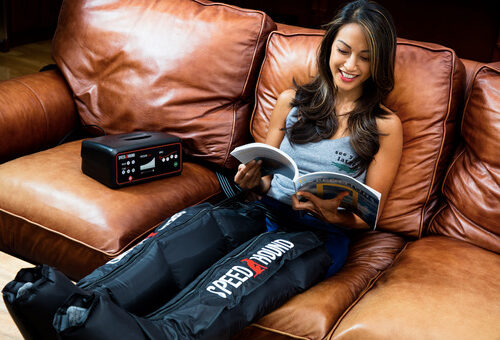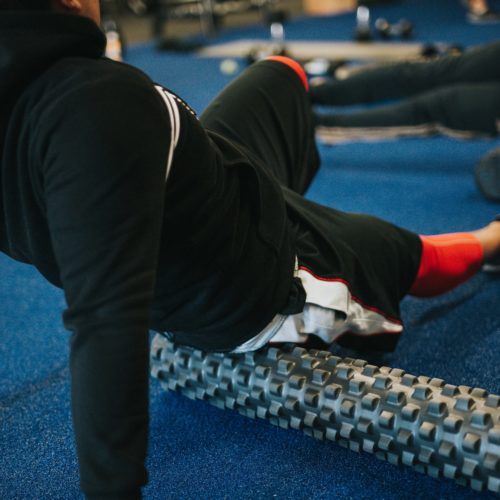5 Must Do’s to Reduce Muscle Recovery Time in Triathlon
Tips for triathletes to incorporate into their training regime to reduce muscle recovery time and maximize performance.

How does an age group athlete (a person with a full time job, family, demanding schedule) still train to chase goals, reduce muscle recovery time and live that active lifestyle that makes them smile?
Young pro-athletes that are paid to train, compete and do marketing for their sponsors have much more time in their schedules for heavy training loads and the needed time to recover. They also typically have access to top notch recovery facilities and tools.
But for the rest of us, How can we sneak in some muscle recovery time into our day, and still log all the training hours we need to chase those goals?
Multi-task! As a competitive age group athlete for 20+ years recovery is key, but with all the demands of my life I need to find some ways to multi-task and accomplish things while I’m recovering.
Here are things I do to recover, stay healthy and crush tomorrow.

1. Prime the pump and hit the anabolic window
Good muscle recovery starts before your workout begins. Making sure you are properly fueled and hydrated ensures you don’t run the tank empty every time you train. This means adding a small meal before training as well as properly fueling during your workout.
Post session refueling is something I (and science) have found to be incredibly helpful for recovery. When I finish a long hard session the first thing I do before I even shower is refuel with a smoothie. My smoothie is pretty much the same thing every day, the key ingredient is the whey protein, and other types of protein powders I use that replenish nutrients to repair the beat up muscles in my body. Flavor preference is key, my typical smoothie has dark chocolate almond milk, a scoop of peanut butter, 3:1 protein powder by F2C Nutrition, ice and a banana. Whatever concoction you make, just make sure you drink it down within 30 minutes of finishing that workout.

2. Heat and cold therapy
Heat and Cold therapy both have their place in reducing muscle recovery time. Each serves a unique purpose and can be added into your regular routine.
The hot epsom salt bath has been a staple for years for me in my recovery. It’s relaxing, soothing and the salts help those aches and pains. Epsom salt baths are key in helping inflammation. Epsom salt is full of magnesium which is key in doing this. The sulfates can help flush toxins out of your body.
Cold/ice baths are exceptional for treating sore muscles and inflammation. These are typically less frequent, reserved for use after big sessions. If the logistics of an ice bath don’t work for you, centralized cold therapy with ice packs is an excellent treatment as well. Focused on a problem area, keeping 15 minutes on every hour can have a tremendously positive effect.

3. Compression muscle recovery
The best thing I’ve done for myself, and has made such a difference in my training, racing, and recovery is getting a Speed Hound pro-performance recovery system. (Refer to the earlier posted article on AgeGrouper about compression recovery.) My compression recovery system massages my legs and promotes blood flow to help repair damaged legs and sore muscles. But it also makes me sit down, relax and kick my feet up. I’ve found this tool to really help aid in what I talked about earlier: multi-tasking. If you can work from home, great and if not that is OK. The key is at some point in our day while watching TV, answering emails, doing research, etc., you can be doing that task while in the pro-performance recovery system. Kick your feet up and help recover your body from the hard sessions earlier in the day.

4. Soft Tissue Work
Soft tissue work is an area that is often overlooked but has tremendous benefit. When done correctly, it is irritating the tissue to produce a chemical response to begin the healing process. Yes, this doesnt mean that soft tissue work isn’t the most comfortable, however the old saying holds true “No pain, no gain”.
The foam roller or the stick like a tiger tail are great tools and used often, along with massage balls for my feet like the method balls. These are easy things to do at home, while working, or after/before a session.
Massage therapy is the pinnacle of soft tissue work. A pinpointed sports massage session is focused on really dialing into those key and troublesome muscles to stimulate faster healing.
I do love soft tissue work, I get massages once in a while, but now since I own the Speed Hound recovery system I can save money and limit my time at the massage studio. Now I use massage more than a few times a year before a major race.
Other options I’ve tried include dry needling and acupuncture. Both I have used in the past and certainly enjoy them and think they work wonderfully, but when budgets, times come into play many of these things get pushed aside and I rely on the tools I have and things I can do at home while multitasking. Which is why a compression recovery system, foam roller, and method balls or a lacrosse ball become the main tools and things I can do daily to help eliminate the cost/time and need to go see professionals that do massage, acupuncture and so on.

5. Sleep, the ultimate performance enhancing drug
Sleep is one of the most important aspects of muscle recovery. During sleep, typically the deep sleep cycle, crucial muscle-building growth hormone is secreted. In addition, during this cycle your muscles relax allowing them to be relieved of tension and can reduce pain.
Adjusting your schedule and bed time to get 7 – 9 hours each night is considered ideal, if you can. Also a brief afternoon nap if you have the ability to will do you wonders!
There are other things to do for recovery, but these are my top difference makers and things that stay consistent in my day to day pursuit of goals as an age group athlete.
Train hard, but don’t forget to carve out time in your day to recover, get off your feet, and get good nutrition.
…
Mike Buenting is a running coach and endurance sport enthusiast out of Excelsior, Minnesota. He actively competes in running races of all distances and triathlons.

